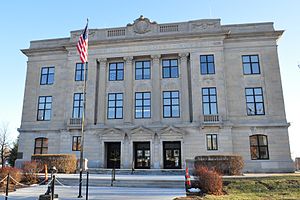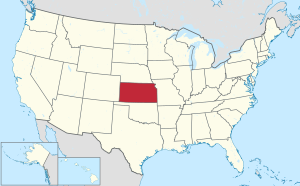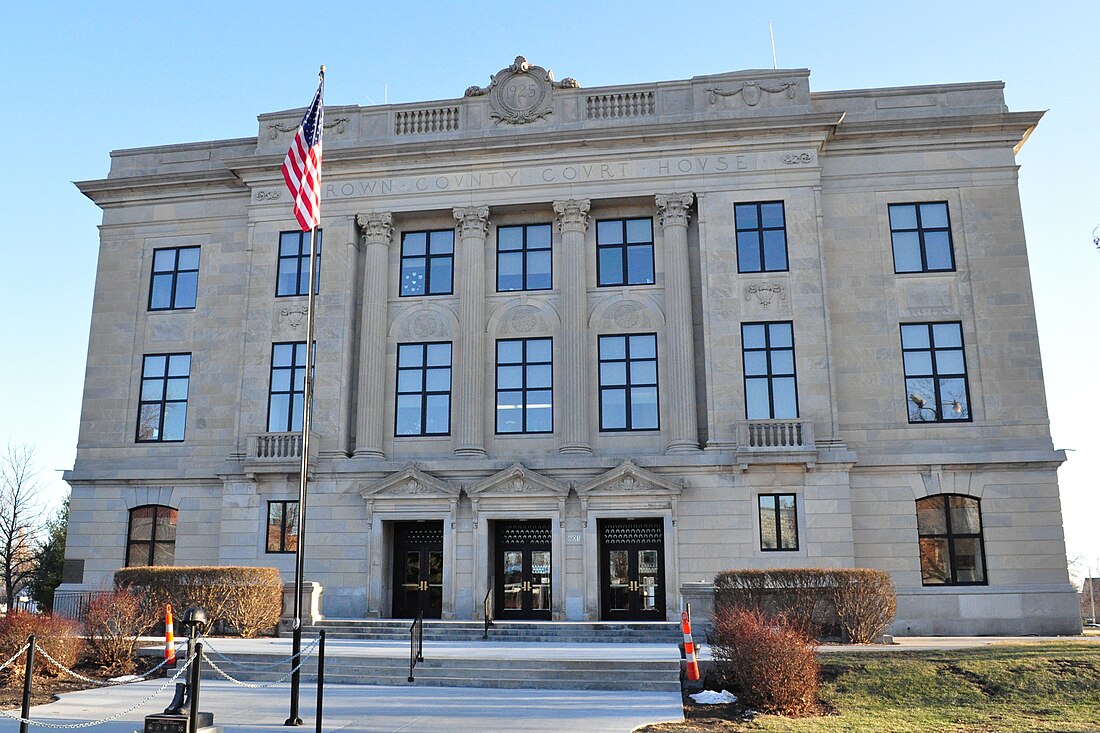Brown County, Kansas
County in Kansas, United States From Wikipedia, the free encyclopedia
Brown County is a county located in the northeastern portion of the U.S. state of Kansas. Its county seat and most populous city is Hiawatha.[3] As of the 2020 census, the county population was 9,508.[1] The county was named after Albert G. Brown, a U.S. Senator from Mississippi and Kansas statehood advocate. The Kickapoo Indian Reservation of Kansas, the majority of the Sac and Fox Reservation, and the majority of the Iowa Reservation of Kansas and Nebraska are located within the county.
Brown County | |
|---|---|
 Brown County Courthouse in Hiawatha (2011) | |
 Location within the U.S. state of Kansas | |
 Kansas's location within the U.S. | |
| Coordinates: 39°48′N 95°35′W | |
| Country | United States |
| State | Kansas |
| Founded | August 25, 1855 |
| Named after | Albert Gallatin Brown |
| Seat | Hiawatha |
| Largest city | Hiawatha |
| Area | |
• Total | 572 sq mi (1,480 km2) |
| • Land | 571 sq mi (1,480 km2) |
| • Water | 1.2 sq mi (3 km2) 0.2% |
| Population | |
• Total | 9,508 |
| 9,250 | |
| • Density | 16.7/sq mi (6.4/km2) |
| Time zone | UTC−6 (Central) |
| • Summer (DST) | UTC−5 (CDT) |
| Area code | 785 |
| Congressional district | 2nd |
| Website | brcoks.org |
History
Early history
For many millennia, the Great Plains of North America was inhabited by nomadic Native Americans. From the 16th century to 18th century, the Kingdom of France claimed ownership of large parts of North America. In 1762, after the French and Indian War, France secretly ceded New France to Spain, per the Treaty of Fontainebleau.
19th century
In 1802, Spain returned most of the land to France, but keeping title to about 7,500 square miles. In 1803, most of the land for modern day Kansas was acquired by the United States from France as part of the 828,000 square mile Louisiana Purchase for 2.83 cents per acre.
In 1854, the Kansas Territory was organized, then in 1861 Kansas became the 34th U.S. state. Brown County was founded in 1855,[4] was named for Albert G. Brown.[5]
Geography
According to the U.S. Census Bureau, the county has a total area of 572 square miles (1,480 km2), of which 571 square miles (1,480 km2) is land and 1.2 square miles (3.1 km2) (0.2%) is water.[6] The Wolf River has its source in the county.[7] Brown State Fishing Lake, formerly known as "Brown County State Park" is in the county, 8 miles (13 km) east of Hiawatha.
Adjacent counties
- Richardson County, Nebraska (north)
- Doniphan County (east)
- Atchison County (southeast)
- Jackson County (southwest)
- Nemaha County (west)
Major highways
Demographics
Summarize
Perspective

| Census | Pop. | Note | %± |
|---|---|---|---|
| 1860 | 2,607 | — | |
| 1870 | 6,823 | 161.7% | |
| 1880 | 12,817 | 87.8% | |
| 1890 | 20,319 | 58.5% | |
| 1900 | 22,369 | 10.1% | |
| 1910 | 21,314 | −4.7% | |
| 1920 | 20,949 | −1.7% | |
| 1930 | 20,553 | −1.9% | |
| 1940 | 17,395 | −15.4% | |
| 1950 | 14,651 | −15.8% | |
| 1960 | 13,229 | −9.7% | |
| 1970 | 11,685 | −11.7% | |
| 1980 | 11,955 | 2.3% | |
| 1990 | 11,128 | −6.9% | |
| 2000 | 10,724 | −3.6% | |
| 2010 | 9,984 | −6.9% | |
| 2020 | 9,508 | −4.8% | |
| 2023 (est.) | 9,250 | [2] | −2.7% |
| U.S. Decennial Census[10] 1790-1960[11] 1900-1990[12] 1990-2000[13] 2010-2020[1] | |||
As of the 2000 census,[14] there were 10,724 people, 4,318 households, and 2,949 families residing in the county. The population density was 19 people per square mile (7.3 people/km2). There were 4,815 housing units at an average density of 8 per square mile (3.1/km2). The racial makeup of the county was 86.87% White, 1.56% Black or African American, 8.82% Native American, 0.21% Asian, 0.01% Pacific Islander, 0.73% from other races, and 1.81% from two or more races. Hispanic or Latino of any race were 2.32% of the population.
There were 4,318 households, out of which 31.40% had children under the age of 18 living with them, 55.80% were married couples living together, 9.20% had a female householder with no husband present, and 31.70% were non-families. 28.80% of all households were made up of individuals, and 15.70% had someone living alone who was 65 years of age or older. The average household size was 2.44 and the average family size was 2.99.
In the county, the population was spread out, with 26.40% under the age of 18, 7.40% from 18 to 24, 24.00% from 25 to 44, 22.70% from 45 to 64, and 19.50% who were 65 years of age or older. The median age was 40 years. For every 100 females there were 93.50 males. For every 100 females age 18 and over, there were 89.80 males.
The median income for a household in the county was $31,971, and the median income for a family was $39,525. Males had a median income of $29,163 versus $19,829 for females. The per capita income for the county was $15,163. About 10.60% of families and 12.90% of the population were below the poverty line, including 16.40% of those under age 18 and 11.80% of those age 65 or over.
Government
Summarize
Perspective
Presidential elections
| Year | Republican | Democratic | Third party(ies) | |||
|---|---|---|---|---|---|---|
| No. | % | No. | % | No. | % | |
| 2024 | 3,106 | 72.67% | 1,065 | 24.92% | 103 | 2.41% |
| 2020 | 3,262 | 72.96% | 1,104 | 24.69% | 105 | 2.35% |
| 2016 | 2,906 | 71.35% | 863 | 21.19% | 304 | 7.46% |
| 2012 | 2,829 | 70.85% | 1,076 | 26.95% | 88 | 2.20% |
| 2008 | 2,985 | 68.21% | 1,317 | 30.10% | 74 | 1.69% |
| 2004 | 3,092 | 69.99% | 1,268 | 28.70% | 58 | 1.31% |
| 2000 | 2,985 | 63.63% | 1,512 | 32.23% | 194 | 4.14% |
| 1996 | 2,688 | 56.58% | 1,529 | 32.18% | 534 | 11.24% |
| 1992 | 2,203 | 41.61% | 1,476 | 27.88% | 1,615 | 30.51% |
| 1988 | 3,059 | 63.57% | 1,719 | 35.72% | 34 | 0.71% |
| 1984 | 3,894 | 73.97% | 1,303 | 24.75% | 67 | 1.27% |
| 1980 | 3,598 | 67.61% | 1,370 | 25.74% | 354 | 6.65% |
| 1976 | 3,407 | 64.96% | 1,745 | 33.27% | 93 | 1.77% |
| 1972 | 4,314 | 78.92% | 1,038 | 18.99% | 114 | 2.09% |
| 1968 | 3,748 | 69.15% | 1,199 | 22.12% | 473 | 8.73% |
| 1964 | 3,213 | 57.01% | 2,386 | 42.33% | 37 | 0.66% |
| 1960 | 4,707 | 72.25% | 1,773 | 27.21% | 35 | 0.54% |
| 1956 | 5,138 | 76.95% | 1,519 | 22.75% | 20 | 0.30% |
| 1952 | 6,031 | 80.51% | 1,440 | 19.22% | 20 | 0.27% |
| 1948 | 4,518 | 67.98% | 2,060 | 31.00% | 68 | 1.02% |
| 1944 | 4,947 | 72.98% | 1,817 | 26.80% | 15 | 0.22% |
| 1940 | 6,008 | 69.18% | 2,633 | 30.32% | 43 | 0.50% |
| 1936 | 5,814 | 62.38% | 3,495 | 37.50% | 11 | 0.12% |
| 1932 | 5,005 | 57.73% | 3,604 | 41.57% | 60 | 0.69% |
| 1928 | 6,692 | 76.77% | 2,005 | 23.00% | 20 | 0.23% |
| 1924 | 5,647 | 68.94% | 1,866 | 22.78% | 678 | 8.28% |
| 1920 | 5,249 | 72.28% | 1,937 | 26.67% | 76 | 1.05% |
| 1916 | 4,282 | 52.86% | 3,503 | 43.25% | 315 | 3.89% |
| 1912 | 1,512 | 31.24% | 1,774 | 36.65% | 1,554 | 32.11% |
| 1908 | 2,778 | 56.31% | 2,044 | 41.44% | 111 | 2.25% |
| 1904 | 3,158 | 68.62% | 1,244 | 27.03% | 200 | 4.35% |
| 1900 | 3,137 | 57.10% | 2,298 | 41.83% | 59 | 1.07% |
| 1896 | 2,879 | 51.65% | 2,618 | 46.97% | 77 | 1.38% |
| 1892 | 2,562 | 52.03% | 0 | 0.00% | 2,362 | 47.97% |
| 1888 | 2,696 | 55.58% | 1,803 | 37.17% | 352 | 7.26% |
Presidential election results
Like all of Kansas outside the eastern cities, Brown County is overwhelmingly Republican, although its history of Yankee settlement means it has been thus for longer than certain other parts of the state. Brown was Alf Landon’s strongest county in his home state during his disastrous 1936 presidential campaign. FDR was never to win so much as 42 percent of the vote in any of his four Presidential elections; indeed no Democratic presidential nominee has ever won a majority in Brown County, with the highest percentage being 47 percent by William Jennings Bryan in 1896. A mortally divided Republican Party allowed Woodrow Wilson to win a plurality in 1912 with under 37 percent of the county’s vote – nonetheless since 1968 no Democrat has reached even that percentage.
Laws
Following amendment to the Kansas Constitution in 1986, the county remained a prohibition, or "dry", county until 2000, when voters approved the sale of alcoholic liquor by the individual drink without a food sales requirement.[16]
Education
- Unified school districts[17]
- School district office in neighboring county
- Bureau of Indian Education-affiliated tribal schools
Communities
Summarize
Perspective

List of townships / incorporated cities / unincorporated communities / extinct former communities within Brown County.[20]
Cities
‡ means a community has portions in an adjacent county.
Unincorporated communities
† means a community is designated a Census-Designated Place (CDP) by the United States Census Bureau.
Indian reservations
Townships
Brown County is divided into ten townships. The cities of Hiawatha, Horton, and Sabetha are considered governmentally independent and are excluded from the census figures for the townships. In the following table, the population center is the largest city (or cities) included in that township's population total, if it is of a significant size.
| Township | FIPS | Population center |
Population | Population density /km2 (/sq mi) |
Land area km2 (sq mi) | Water area km2 (sq mi) | Water % | Geographic coordinates |
|---|---|---|---|---|---|---|---|---|
| Hamlin | 29725 | 344 | 3 (8) | 106 (41) | 0 (0) | 0.18% | 39°57′1″N 95°36′40″W | |
| Hiawatha | 31700 | 739 | 4 (12) | 164 (63) | 0 (0) | 0.18% | 39°50′25″N 95°31′59″W | |
| Irving | 34500 | 311 | 2 (6) | 137 (53) | 0 (0) | 0.04% | 39°57′24″N 95°23′36″W | |
| Mission | 47200 | 645 | 3 (8) | 219 (84) | 2 (1) | 0.73% | 39°43′14″N 95°32′12″W | |
| Morrill | 48325 | Morrill | 503 | 5 (12) | 105 (41) | 0 (0) | 0.24% | 39°56′23″N 95°43′20″W |
| Padonia | 54025 | 259 | 2 (6) | 107 (41) | 0 (0) | 0.14% | 39°57′2″N 95°31′4″W | |
| Powhattan | 57375 | 874 | 4 (10) | 232 (90) | 0 (0) | 0.06% | 39°43′49″N 95°41′59″W | |
| Robinson | 60350 | Robinson | 452 | 4 (10) | 116 (45) | 0 (0) | 0.25% | 39°48′29″N 95°23′49″W |
| Walnut | 74875 | Fairview | 665 | 4 (11) | 161 (62) | 1 (0) | 0.46% | 39°50′53″N 95°42′27″W |
| Washington | 75525 | Everest | 541 | 5 (12) | 116 (45) | 0 (0) | 0.17% | 39°41′43″N 95°24′41″W |
| Sources: "Census 2000 U.S. Gazetteer Files". U.S. Census Bureau, Geography Division. Archived from the original on August 2, 2002. | ||||||||
See also
- Community information for Kansas
References
Further reading
External links
Wikiwand - on
Seamless Wikipedia browsing. On steroids.
